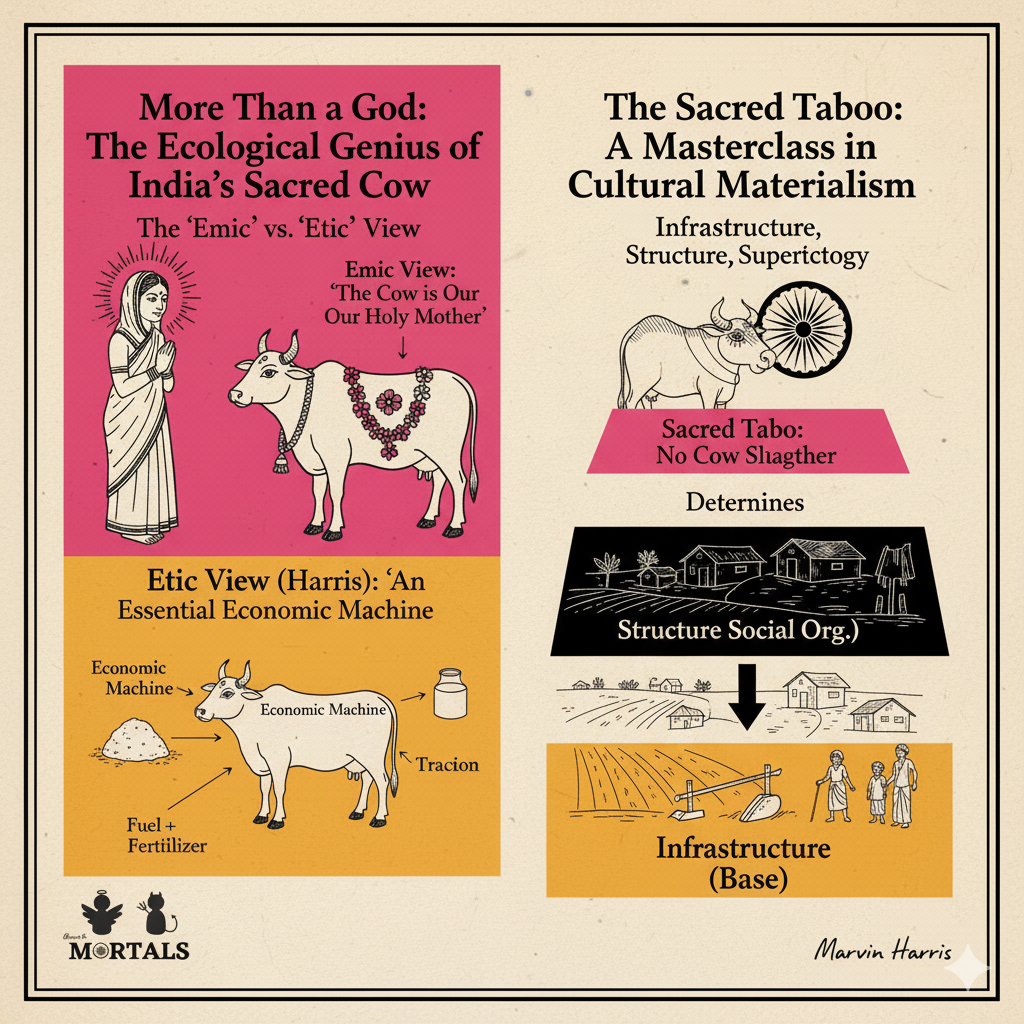To many in the West, the image of the sacred cow wandering freely through the bustling streets of India is the ultimate symbol of a culture where religious dogma trumps practical reason. The common criticism is: why protect millions of seemingly useless cattle when so many people are poor? In the 1960s, the iconoclastic American anthropologist Marvin Harris launched a direct assault on this ethnocentric view. He argued that the Hindu taboo against cow slaughter, far from being an economic burden, is the very foundation of the entire traditional agricultural system. This case study explores his masterclass in Cultural Materialism.
The Information Box
Syllabus Connection:
- Paper 1: Chapter 6 (Anthropological Theories: Cultural Materialism), Chapter 10 (Ecological Anthropology), Chapter 3 (Economic Anthropology)
- Paper 2: Chapter 4 (Religion and Society in India)
Key Concepts/Tags:
- Marvin Harris, Cultural Materialism, Sacred Cow, Etic Perspective, Cultural Ecology, Infrastructure-Structure-Superstructure
The Setting: Who, What, Where?
This is the intellectual world of Marvin Harris, the leading proponent of the Cultural Materialism school of thought. His famous analysis is detailed in his 1966 essay, “The Cultural Ecology of India’s Sacred Cattle,” and popularized in books like The Sacred Cow and the Abominable Pig. Harris was not an Indologist; he was a grand theorist who used the role of cattle in the rural Indian agricultural system as a prime case study to demonstrate his universal, materialist approach to understanding human societies.
The Core Argument: Why This Study Matters
Harris’s work provided a powerful, materialist alternative to purely religious or ideological explanations for cultural practices.
- The “Etic” (Outsider) Perspective: Harris insisted on taking an etic—or outsider, scientific—perspective. He argued that to understand a cultural practice, we should not focus on what the people say about it (the emic view, e.g., “the cow is our holy mother”). Instead, we should analyze the observable, material effects the practice has on their survival and environment.
- Challenging the “Irrationality” Thesis: He systematically dismantled the argument that the taboo is economically irrational. He argued that the temptation to kill cattle for meat during a famine, while logical in the short term, would be a form of long-term ecological suicide for the entire agricultural system.
- The Cow as an “Economic Machine”: This is the heart of his materialist explanation. Harris broke down the indispensable, practical functions the cow performs in the “infrastructure” of rural life:
- A Factory for Traction: A cow’s primary value is not its meat, but its ability to produce oxen. For a poor farmer without a tractor, a pair of bullocks is the essential means of production for ploughing the fields. To kill a cow is to destroy the factory that produces your tractors.
- A Source of Fuel and Fertilizer: Cow dung provides a vital and free source of cooking fuel (in the form of dried dung cakes), which saves precious firewood. It is also the principal fertilizer used to maintain the fertility of the fields.
- A Producer of Milk: Even if they are not high-yield dairy animals, they provide a small but regular source of essential protein for the family.
- The Sacred Taboo as an Ecological Masterstroke: Harris’s stunning conclusion was that the religious “superstructure” (the belief that the cow is sacred) is a cultural adaptation that protects the vital economic “infrastructure.” The religious taboo is a powerful social command that prevents individuals from making a short-sighted and collectively disastrous decision (killing their cattle), thereby ensuring the long-term sustainability of the entire agro-ecosystem.
The Anthropologist’s Gaze: A Critical Perspective
Harris’s powerful and elegant theory has been the subject of intense debate.
- Is it Overly Deterministic?: The most common critique of Cultural Materialism is that it represents a form of techno-environmental determinism. By giving such absolute primacy to the material infrastructure, does Harris’s model deny the real, independent power of religion, ideology, and human agency in shaping culture? Is the taboo just an ecological strategy, or does it also have a profound, non-material spiritual meaning for believers?
- Ignoring the Insider’s View (Emic): By deliberately setting aside the emic perspective, critics argue that Harris presents a sterile and overly mechanistic view of culture. He explains the “function” from an outsider’s point of view but ignores the rich, lived experience and meaning of the religious belief for the people themselves. This provides a stark contrast to the ideological approach of Louis Dumont.
- The Problem of Inefficient Cattle: Some economists and Indologists have challenged Harris’s data, arguing that he might have romanticized the efficiency of the system. They point to the real economic costs of maintaining a large population of old and unproductive cattle, suggesting that the reality is more complex than his neat functionalist model allows.
The Exam Angle: How to Use This in Your Mains Answer
- Types of Questions Where It can be Used:
- “Critically evaluate the theory of Cultural Materialism in anthropology.”
- “Analyze the relationship between religion and economy with suitable ethnographic examples.”
- “Discuss the contributions of Ecological Anthropology to the understanding of human-society-environment interactions.”
- Model Integration:
- On Cultural Materialism: “Cultural Materialism, championed by Marvin Harris, seeks to explain cultural practices through an etic, materialist lens. His classic analysis of India’s ‘sacred cow’ is a prime example, where he argued that the religious taboo against cow slaughter is a superstructural justification for a rational ecological adaptation that preserves cattle for traction and fuel.”
- On Ecological Anthropology: “Ecological anthropology analyzes the functional relationship between culture and environment. Marvin Harris’s study of the sacred cow demonstrated this by showing how a seemingly irrational religious belief serves a crucial ecological function in maintaining the long-term stability of the Indian agro-ecosystem.”
- To offer a critique: “While Marvin Harris’s materialist explanation for the sacred cow taboo is powerful, it has been critiqued for its techno-environmental determinism. Critics argue that by reducing the religious belief to a purely ecological function, his model downplays the independent power of ideology and the emic (insider’s) spiritual meaning of the practice.”
Observer’s Take
Marvin Harris’s analysis of the sacred cow is a classic of anthropological provocation. It forces you to look at a familiar cultural symbol in a completely new and unsentimental light. Whether one fully agrees with his materialist explanation or not, the genius of his argument lies in its powerful challenge to our own ethnocentric assumptions. Harris taught us to be deeply skeptical of dismissing other cultures’ practices as “irrational” and to always search for the hidden, practical logic that might lie beneath the surface of a seemingly strange belief. The story of the sacred cow is a powerful reminder that sometimes, the most sacred things are also the most profoundly practical.





